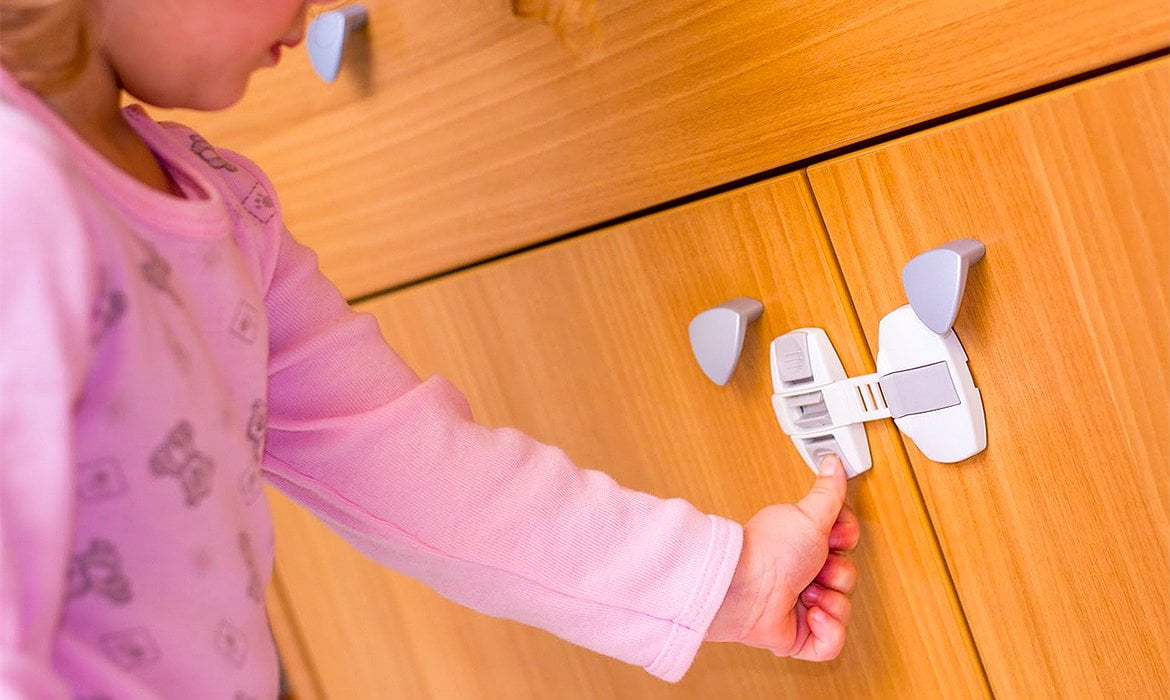
You may be surprised at how easy it is for babies to get into trouble around the house. It’s difficult to anticipate at what point you should baby-proof your home. Before you know it your child is ready to start rolling over, crawling and eventually walking. That’s why it’s important to take the time to baby-proof when they’re brand new or even before they arrive.
Plan to set aside one weekend to secure your newly purchased home or rental condo, room by room to baby-proof. It may only take you several hours total, and once it’s out of the way you will have so much peace of mind, even though you’ll need to update your efforts as your baby grows. Follow these tips to baby proof your home and keep your little bundle of joy safe as it arrives.
Start As Soon As Possible
Baby-proofing your home can take up more time than you might think. Make sure you have all of the safety basics covered and emergency plans in place, so you’re ready to take action. Some preparations will take time, so it’s easiest to baby proof your home before your little one arrives. Your hands will be full as soon as your baby arrives so if you can complete projects ahead of time you’ll be glad you did.
Make a Game Plan
Before you feel overwhelmed with a project like baby proofing, look at your options and make yourself a strategy. One strategy is to perform all of the necessary tasks and upgrades one room at a time. For instance, securing the kitchen before moving on to the living room is one strategy. Alternatively, you could strategize by categories such as cabinet and go through the house installing cabinet locks before moving on to the next item.
No matter which approach, addressing these life-threatening precautions first and then working your way toward those that might only cause bumps and bruises is important. Studies have shown that choking and suffocation are the biggest hazards for children less than one-year-old.
Tie It Down
Use furniture straps to hold down TVs, bookshelves, dressers and other heavy furniture in place in any room where your child might be left alone, even for a minute. Don’t put a TV on top of a dresser, as the drawers can be used for climbing. Secure corner or edge bumpers on any furniture with sharp edges.
Eliminate Strangling and Choking Hazards
Removing small items that your child can choke on is a constant challenge. Even food that’s dropped from the dinner table can be hazardous if it’s the wrong size and shape. There are precautions you can take to minimize these risks such as:
- Vacuuming regularly to pick up small items.
- Tying back cords on blinds or curtains, or installing cordless blinds will minimize the risk of strangling.
- Remove the plastic caps on doorsteps – considered to be choking hazards.
- Reorganize any small items such as refrigerator magnets, batteries, paper clips and other household items out of reach of tiny hands.
- Move any plastic dry-cleaner or grocery bags to a secure location
Prevent Shocks
Put outlet covers on all electrical outlets to prevent your little one from getting an electric shock. There are some outlets that can be a choking hazard if a baby or a toddler manages to pry them out of the wall. There are “child proof” covers that you can buy that requires two hands to remove or cover plates that screw on. As an added level of protection you can always place large pieces of furniture in front of outlets.
Address Any Poisoning Risks
Bottom cabinets and drawers should only be used to store items that are safe for baby to find, even with the safety latches attached. Pots, pans and food storage containers, for example may leave a bruise, but they’re unlikely to harm your child. You can also secure your home by; eliminating any toxic houseplants, transfer cleaning supplies and detergents to high or locked cabinets, clear medicines, vitamins, cosmetics, and shampoos off of counters. Moving them into a high or locked cabinet will do the trick.
Limit Baby’s Movement
If there are some rooms you would like to remain baby proof free, use baby gates to keep your little one from getting into them. Installing gates at the top and bottom of the stairs before your baby is mobile will pay off in the future. Don’t use accordion-style gates, as they can trap the baby’s head. Look for gates that attach securely to the wall but won’t pinch small fingers.
Not Always Having to Say No
Having a safe space for you children means you won’t always have to say “no.” Moving things that are fragile or breakable saves the object while simultaneously preventing your child from being cut or bruised. Even if your child is obedient and follows the rules, you will still need to baby proof your home; it only takes a moment for little ones to get into something they should not touch.
Contact a Royal City REALTOR® today!
Looking for an experienced REALTOR® that specializes in the local real estate? At Royal LePage® Royal City Realty we are focused on helping you unlock your future.
